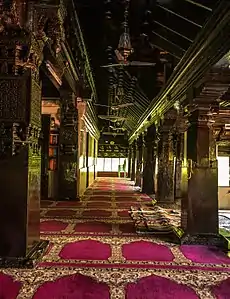Islam in Assam
Islam is the second largest religion in Assam. Islam is also fastest growing religion in Assam according to 2011 census report. According to the 2011 census, the population of Assam is roughly 31,205,576 out of which there were 10,679,345 Muslims in the Indian state of Assam, forming over 34.22% of its population. Muslims are majority in almost eleven districts of Assam and also highest concentration found in four districts according to 2011 census.[1]
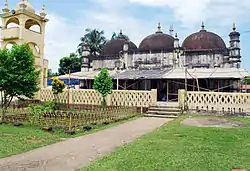 Panbari Mosque, the oldest mosque in Assam | |
| Total population | |
|---|---|
| c. 10.6 million | |
| Regions with significant populations | |
| Assam | |
| Languages | |
| Arabic (religious), Assamese, Bengali, Urdu |
| Part of a series on |
| Islam in India |
|---|
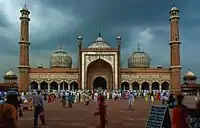 |
History
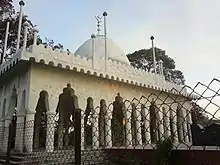

The migration of Turks to India has opened a new historical page in this geography although Turco-Indo relations has a long old history. Before the arrival of Islam, Saka, Kuşan, Akhun and Turkish Sufi were present in this geography. After the arrival of Islam during the 1000-1027 AD, Mahmud of Ghazni led his force to India for 17 times, which left deep impacts on the Indian mindset.[2]
The first Turco-Islamic military campaign to India began in 1001.[3] As mentioned in chronicles of history, the first of Turks, Muhammad bin Bakhtiyar Khalji, came to the India's North-eastern province Assam in 1206. The Turks were on an expedition to capture Tibet and perhaps China. At the beginning they came with a force of 10-12,000 horsemen to the unexplored region named Kamrup (Old Name: Kamrup, Kamarupa, New Name: Assam) crossing the mountainous region of Northern parts of Bihar and Bengal”.[4] The Turkish forces were quite instable in Kamrup. A chieftain of the Mech converted to Islam at the invitation of Muhammad bin Bakhtiyar Khalji, and adopted the name Ali Mech Raja. He guided Khalji's army through the region known as Kamarupa during the expedition.[5][6] In 1498, Hussain Shah invaded Kamarupa and Kamata and issued coin with title "Conqueror of Kamru and Kamta".[7] Islam became popularised in the Barak Valley of Assam with the arrival of the Sufi Shah Jalal and his disciples in the early 14th century. A large part of the valley came under the Bengal Sultanate. Since then Muslims continue to play important role in all walks of life in Assam.
In 1613, the Mughal emperor Jahangir appointed Muhammad Zaman Karori of Tehran as the Amil of Sylhet. Zaman took part in Islam Khan I's Assam expedition and was instrumental to the capture of Koch Hajo.[8] The Mughals also ruled Goalpara (as a part of their Bengal Subah), but could not subdue the other parts of Assam.[9] The Mughal soldiers who were taken as prisoners of wars by the Assamese kingdoms were later assimilated by the local population, but maintained their Islamic beliefs and worked as brass metal workers.
In 1630, a Muslim saint named Shah Miran, popularly known as Ajan Fakir, came from Baghdad, the present capital city of Iraq, to Sibsagar area of Assam. He preached to the local population about Islam and as a result, many converted to Islam and became his disciples. His mausoleum is present in Saraguri Chapori in Assam's Sivasagar district.
Lutfullah Khan Shirazi, the faujdar of Guwahati, built a hilltop mosque in Hajo in 1657.[8] Assamese language was the lingua-franca of the North-eastern province among the various distinctive indigenous ethnicities and still is. The majority of the speakers live in the Brahmaputra valley, Assam, India.
British Raj
When Assam came under colonial rule, the British brought with them a number of immigrant Bengali settlers (mostly Muslims). These immigrant Bengalis encouraged other Bengalis to settle in Assam for economic and social reasons.[10] The fertile land of Assam and its vast expanse was inhabited by only a moderate indigenous populace at that time( that is vast lands and forests were present but less people) which then attracted a large number of landless immigrant peasants from Bengal presidency, nearly 85% of whom were Muslims. These immigrant Bengali-speaking ethnic Bengali continued migrating into Assam and got assimilated there. The tea planters and immigrant Marwari businessmen, who needed workers, also welcomed the migrants.[11]
Early establishments of these neo-coloniser immigrant Bengalis were in the Goalpara district, mostly in the char (riverine) lands and reserved forests.[10] Most of these Muslim immigrants were known as "Miyas". Since many of them came from the Northeast part of Rangpur and very few of them came from Mymensing, they were sometimes referred to as "Bongya" or Bongali meaning Outsider.[12]
After the Government of India Act 1935, a Legislative Assembly was established in Assam in 1937. The Muslim League, led by Muhammed Saadulah, formed a minority government in the state and he again encouraged large scale immigration from then Bangladesh.[11]
Independence
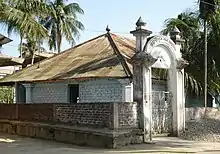
After the Sylhet referendum in 1947, the Muslim-majority Sylhet region went to East Pakistan while some Muslim-majority areas such as the Karimganj district went to Assam, India.[13][14]
Assam has some indigenous Muslims like Goria, Moria and Deshi but they are very few as compared to the large-scale immigrant outsider Bangladeshi people. Thus, there have been concerns that illegal immigration from neighbouring Bangladesh has contributed to a sharp rise in the Muslim population of Assam and has slowly destabilized the native inhabitants of Assam. This fear of "demographic invasion" by Bangladeshi has been a political issue in Assam since the days of the Assam Movement (1979–1985).[15] In 2001, there were 6 Muslim-majority districts in the state of Assam. By 2011, this number had increased to 9.[16] However, some have stated these numbers have declined in recent years, though there is no concrete proof.[17]
Assam Movement
The Assam Movement or the Assam Agitation (1979-1985) led by All Assam Students Union (AASU) and the ‘All Assam Gana Sangram Parishad’ (AAGSP) was a popular uprising to drive out the illegal immigrants from Bangladesh. The movement ended with the signing of the Assam Accord by leaders of AASU-AAGSP and the Government of India under PM Rajiv Gandhi. During this period of six long years of the historic movement, reportedly, 855 people (later on 860 according to AASU reports) sacrificed their lives in the hope of an “infiltration free Assam” in the 1979-1985 Assam agitation. In addition, the infamous Nellie and Khoirabari massacre also took place during this time claiming the lives of 2,191 and 100-500 respectively.
Assam Accord
The Assam Accord (1985) was a Memorandum of Settlement (MoS) signed between representatives of the Government of India and the leaders of the Assam Movement for the indigenous ethnic groups in New Delhi on 15 August 1985. The fundamental aspect of the Assam Accord was: foreigners who came to Assam on or after March 25, 1971 shall continue to be detected; deleted and practical steps shall be taken to expel such foreigners. The indigenous people of Assam (by meaning indigenous is for those who are living since ages even before colonization took place in 1826 as per UN definition of the indigenous people). Further details are available on public domain which can be referred to, for detailed information.
Post 1985, Assam witnessed a multiple change of governments; from the Indian National Congress to the Assam Gana Parishad and finally the BJP's maiden entry in 2016 with CM Sarbananda Sonowal at the helm, an erstwhile member of AASU who also signed the Assam Accord.
State-Run Islamic Schools
An Indian state ruled by Narendra Modi’s Hindu nationalist party has passed a law converting state-run Islamic schools into regular schools, saying they provided sub-standard education.
Opposition parties criticised the move and stated it reflected the government’s anti-Muslim attitude in the Hindu-majority country.
More than 700 of the schools, known as madrasas, in Assam will be shut by April, the state’s education minister Himanta Biswa Sarma told the local assembly. [18]
Language and ethnicity
Languages spoken among the Muslims of Assam
- Bengali Muslims: Most of the Muslims in Assam are known as Miya that is immigrant east Bengal origin people and their descendants, and originate from Eastern Bengal and modern-day Bangladesh. They are concentrated in the central and lower Assam districts such as Dhubri, Morigaon, Goalpara, Hojai, Kamrup, Darrang, Nagaon, Bongaigaon, Barpeta and Bodoland Territorial Region. Their population is around 6.55 million if the exact populace is calculated in Assam comprising about 21% islamic share of the state population out of 34% Muslims as of 2011. The Muslims of the Barak Valley and Hojai district speak in the Sylheti language. The valley's Karimganj district was historically a part of the Sylhet region and was separated from the region during the Partition of India. The nearby Cachar and Hailakandi districts of the Barak Valley historically part of Dimasa Kingdom, though not a part of greater Sylhet, also host a large Sylheti Muslim population.
- Indigenous Assamese Muslims: The Goriya's, Mariya's, Deshi and Syed are the group of Muslims who speak Assamese as their own mother tongue and tend to identify themselves as Assamese Muslims who are living here since ages and are actually mostly local converts from the existing indigenous ethnic groups. There are also the descendants of the defeated Mughal soldiers who were captured in the Ahom-Mughal battle and with the passage of time, some have married the native Assamese girls and have adopted the Assamese language and culture. Their total population is about 4 million which comprise 12% of state population.
- Hindustani-speaking Bihari and UP Muslims: These migrant Muslims generally originate from Uttar Pradesh and Bihar and speak in Urdu or Hindi. Their population is about 6 lakhs in Assam comprising 2% of state population as of 2011 and are mainly found in Brahmaputra valley.
Ethnic tag
- Deshi
- These are descendants from Koch-Rajbonshi, Mech, Rabha, Bodo and Indo-Aryan people who converted to Islam. They mainly speak the Goalpariya dialect. They are mainly settled in the districts of Dhuburi, Goalpara, South Salmara and Kokrajhar.
- Maria
- These are descended from the captured Muslim soldiers, who came with the armies of Khalji (1206) and Turbak of Gaur (1532). They are named as such because they were engaged in the bell-metal and smithy industry, the word Maria meaning one who hits metals. They are very minority in numbers and can be found in Sivsagar, Jorhat, Tinsukia, Golaghat, Kamrup, etc. They speak Assamese language as their own mother tongue.
- Zula
- They are one of the indigenous Muslims of Assam. They are mainly found in Lower Assam.
- Sylhetis
- These Bengali Muslims live in the Barak Valley of the Greater Sylhet region of Northeast Bengal (South Assam).
The Assamese Muslim community includes mainly Goria and Maria who use Assamese as their mother tongue.
Human Rights issues
Bengali Muslims in Assam have faced repeated and increased attacks.[19] In 1983, around 3000 Bengali Muslims were killed in the Nellie massacre.[20]
During the 2012 Assam violence there was communal riot between Bangladeshi origin Muslim and indigenous Bodo people.[21] Indian nationalist politicians have accused Bangladesh of trying to expand its territory by ostensibly promoting illegal immigration. However, Indian government census reports note a decline in immigration from Bangladesh between 1971 and 2011.[17][22]
Population
| Year | Muslim Population | Increase | % Increase | % of total population |
|---|---|---|---|---|
| 1901 | 303,170 | 15.03% | ||
| 1911 | 634,101 | 330,931 | 50.9% | 16.21% |
| 1921 | 880,426 | 246,325 | 38.25% | 18.74% |
| 1931 | 1,279,388 | 398,962 | 45.31% | 22.78% |
| 1941 | 1,696,978 | 417,590 | 32.64% | 25.13% |
| 1951 | 1,995,936 | 298,958 | 17.62% | 24.68% |
| 1961 | 2,765,509 | 769,573 | 38.56% | 25.30% |
| 1971 | 3,594,006 | 828,497 | 29.96% | 24.56% |
| 1991* | 6,373,204 | 2,779,198 | 77.33% | 28.43% |
| 2001[23] | 8,240,611 | 1,867,407 | 29.30% | 30.92% |
| 2011[1] | 10,679,345 | 2,438,734 | 29.59% | 34.22% |
* Variation for two decades (1971–1991). In 1981, census was not conducted in Assam due to disturbed conditions resulting from insurgency. Muslim percentage have increased from 15.03% in 1901 to 34.22% in 2011 (which is a sharp rise of 25.01% for past 110 years). The estimated Muslim population of Assam for upcoming 2021 census is 13 million out of 35 million total population, making up 37.14% of the state population.[24][25]
Population by district
Below is a breakdown of the Muslim population by district in the Indian state of Assam according to the 2011 Census of India: [1] Muslims are majority in eleven districts out of thirty-three in Assam. Muslims are majority in Dhubri, Bongaigaon, Goalpara, Barpeta, Morigaon, South Salmara district, Hojai, Nagaon, Darrang, Karimganj and Hailakandi. Highest concentration in Cachar, Nalbari, Kokrajhar and Chirang.
| # | District | Total population | Muslim population | Percentage |
|---|---|---|---|---|
| 1 | Baksa | 950,075 | 135,750 | 14.29% |
| 2 | Barpeta | 1,693,622 | 1,198,036 | 70.74% |
| 3 | Bongaigaon | 738,804 | 371,033 | 50.22% |
| 4 | Cachar | 1,736,617 | 654,816 | 37.71% |
| 5 | Chirang | 482,162 | 109,248 | 22.66% |
| 6 | Darrang | 928,500 | 597,392 | 64.34% |
| 7 | Dhemaji | 686,133 | 13,475 | 1.96% |
| 8 | Dhubri | 1,949,258 | 1,553,023 | 79.67% |
| 9 | Dibrugarh | 1,326,335 | 64,526 | 4.86% |
| 10 | Dima Hasao | 214,102 | 4,358 | 2.04% |
| 11 | Goalpara | 1,008,183 | 579,929 | 57.52% |
| 12 | Golaghat | 1,066,888 | 90,312 | 8.46% |
| 13 | Hailakandi | 659,296 | 397,653 | 60.31% |
| 14 | Jorhat | 1,092,256 | 54,684 | 5.01% |
| 15 | Kamrup | 1,517,542 | 601,784 | 39.66% |
| 16 | Kamrup Metropolitan | 1,253,938 | 151,071 | 12.05% |
| 17 | Karbi Anglong | 956,313 | 20,290 | 2.12% |
| 18 | Karimganj | 1,228,686 | 692,489 | 57.36% |
| 19 | Kokrajhar | 887,142 | 252,271 | 28.44% |
| 20 | Lakhimpur | 1,042,137 | 193,476 | 19.57% |
| 21 | Morigaon | 957,423 | 503,257 | 52.56% |
| 22 | Nagaon | 2,823,768 | 1,563,203 | 55.36% |
| 23 | Nalbari | 771,639 | 277,488 | 34.96% |
| 24 | Sivasagar | 1,151,050 | 95,553 | 9.30% |
| 25 | Sonitpur | 1,924,110 | 350,536 | 17.22% |
| 26 | Tinsukia | 1,327,929 | 48,373 | 3.64% |
| 27 | Udalguri | 831,668 | 105,319 | 12.66% |
| 28 | Hojai | 931,218 | 499,565 | 53.65% |
| 29 | South Salmara district | 249,508 | 244,590 | 98.03% |
| Assam (Total) | 31,205,576 | 10,679,345 | 34.22% |
Trends
"Muslim percentage by decades"[26]
| Year | Percent | Increase |
|---|---|---|
| 1801 | 5.94% | N/A |
| 1811 | 6.75% |
+0.81% |
| 1821 | 7.63% |
+0.88% |
| 1831 | 8.23% |
+0.6% |
| 1841 | 9.51% |
+1.28% |
| 1851 | 10.63% |
+1.12% |
| 1861 | 11.77% |
+1.14% |
| 1871 | 12.95% |
+1.18% |
| 1881 | 13.83% |
+0.88% |
| 1891 | 14.56% |
+0.73% |
| 1901 | 15.03% |
+0.47% |
| 1911 | 16.21% |
+1.18% |
| 1921 | 18.74% |
+2.53% |
| 1931 | 22.78% |
+4.04% |
| 1941 | 25.13% |
+2.35% |
| 1951 | 24.68% |
-0.45% |
| 1961 | 25.30% | +0.62% |
| 1971 | 24.56% | -0.74 |
| 1991 | 28.43% | +3.87% |
| 2001 | 30.92% | +2.48% |
| 2011 | 34.22% | +3.31% |
Islam was first introduced in Assam by Pir Azan who have came from Baghdad in 17th century (1601-1700) during the reign of Ahom king Pratap Singha. He preach Islam to local indigenous assamese tribes in various parts of Assam. He played a vital role in unifying the people of the Brahmaputra Valley. He is considered as a legendary sufi saint who composed many spiritual songs related to Allah in Assamese language. Thousands of devotees from all over the country visit his Dargah at Sivsagar to pay their homage to this great reformer who had done a lot for the people of Assam.[27]
Notable Assam Muslims
- Fakhruddin Ali Ahmed, the only Assamese president of India
- Bagh Hazarika
- Mafizuddin Ahmed Hazarika, writer
- Adil Hussain, actor
- Wasbir Hussain, journalist
- Baharul Islam, Justice of the Supreme Court of India
- Syed Abdul Malik, writer
- Ali Mech, First converted Muslim of Assam
- Abu Nechim, the first Assamese Muslim IPL cricketer
- Muhammed Saadulah, the only Assamese Muslim member of the drafting committee of the constituent assembly of India
- Imran Shah, writer
- Parveen Sultana, Padma Bhushan vocalist
- Anwara Taimur, the only woman chief minister of Assam
- Zerifa Wahid, actor
- Abdul Matlib Mazumdar, Indian freedom fighter and political leader based in undivided Assam State. He was the most prominent Muslim opponents of the demand for a separate Muslim state of Pakistan, especially in the eastern part of the country.
- Badruddin Ajmal, member of the Indian Parliament[30] from Dhubri Lok Sabha constituency; founder of the Assam United Democratic Front (AUDF), now All India United Democratic Front (AIUDF);[31] president of the Assam State Jamiat Ulema-e-Hind; Industrialist, Businessman and a Social worker.
References
- 2011 Census Data: Assam.
- MALKOÇ, Eminalp (2017). "Journal of Eurasian Studies / Avrasya İncelemeleri Dergisi". Journal of Eurasian Inquiries / Avrasya İncelemeleri Dergisi. Istanbul University: 110. doi:10.26650/jes.
- Bokuleva, Bota; Avakova, Rauşangül; Abeldayev, Jenisbek (1 May 2012). "Türk Kültürünün Hindistan Uygarlığına Etkisi". Türk Dünyası İncelemeleri Dergisi. 12 (1): 442. ISSN 1301-2045.
- Bayur, Yusuf Hikmet. (1946–1947). Hindistan tarihı ... : Y. Hikmet Bayur ... Türk tarih kurumu basımevi. p. 273. OCLC 458672248.
- Muhammad Mojlum Khan (2013). The Muslim Heritage of Bengal. Kube. p. 18. ISBN 9781847740625.
- D. Nath (1989). History of the Koch Kingdom, c. 1515 – 1615. Mittal. p. 9. ISBN 9788170991090.
- Sircar, D. C. (2008). Studies in Indian Coins. Motilal Banarsidass Publishe. ISBN 978-81-208-2973-2.
- Syed Mohammad Ali. "A chronology of Muslim faujdars of Sylhet". The Proceedings Of The All Pakistan History Conference. 1. Karachi: Pakistan Historical Society. pp. 275–284.
- Sanjib Baruah (1999). India Against Itself: Assam and the Politics of Nationality. University of Pennsylvania Press. p. 24. ISBN 9780812234916.
- Jayashree Roy (2003). Decentralisation Of Primary Education in the Autonomous District Council of Karbi Anglong - Assam (PDF). National Institute of Educational Planning and Administration. p. 10.
- N. S. Saksena (1985). Terrorism History and Facets: In the World and in India. Abhinav Publications. p. 165. ISBN 978-81-7017-201-7.
- "Assam: Religion and Caste". Government of Assam. Archived from the original on 31 August 2012. Retrieved 28 August 2015.
- Chowdhury, Dewan Nurul Anwar Husain. "Sylhet Referendum, 1947". en.banglapedia.org. Banglapedia. Retrieved 20 November 2016.
- "Recovering Sylhet - Himal Southasian". himalmag.com. Himal Southasian. 22 November 2012. Retrieved 20 November 2016.
- "Census 2011 data rekindles 'demographic invasion' fear in Assam". hindustantimes.com. Retrieved 30 May 2016.
- "Muslim majority districts in Assam up - Times of India". timesofindia.indiatimes.com. Retrieved 30 May 2016.
- Roy, Sandip (16 August 2012). "The illegal Bangladeshi immigrant: Do the bogeyman numbers add up" (1). Firstpost. Firstpost. Retrieved 14 February 2016.
- "India's Assam state converts state-run Islamic schools into regular schools all islamic schools". theguardian.com. Retrieved 31 December 2020.
- Andre, Aletta; Kumar, Abhimanyu (23 December 2016). "Protest poetry: Assam's Bengali Muslims take a stand". Aljazeera. Aljazeera. Retrieved 26 January 2017.
- "Memory and forgetting in Nellie - Livemint". livemint.com. Retrieved 30 May 2016.
- "Assam Timeline - Year 2014". www.satp.org. Retrieved 12 October 2018.
- Deka, Dr. Kaustubh (3 June 2014). "BJP leaders warn illegal Bangladeshis to leave, but census figures refute the myth of large-scale infiltration Rate of growth of Assam's population has been declining since 1971" (1). Scroll.in. Scroll.in. Retrieved 14 February 2016.
- Population by religious communities, 2001 Census of India
- https://www.thehindu.com/news/national/assam-plans-survey-to-identify-indigenous-muslim-population/article30780667.ece
- http://www.populationu.com/in/assam-population
- http://www.cpsindia.org › BlogsPDF Decline of Hindus and the Rise of Muslims in Assam
- https://m.timesofindia.com/city/guwahati/Women-offer-namaz-in-Sivasagars-Ajan-Peer-Dargah-for-first-time/articleshow/10791866.cms
- http://indiafacts.org/will-assam-muslim-majority-next-40-years/
- Scroll.in Socio-economic factors, not religion, influence India's fertility
- "15th Lok sabha members, Assam, India". Archived from the original on 25 September 2015. Retrieved 30 June 2012.
- http://www.aiudf.org AIUDF Official Website
